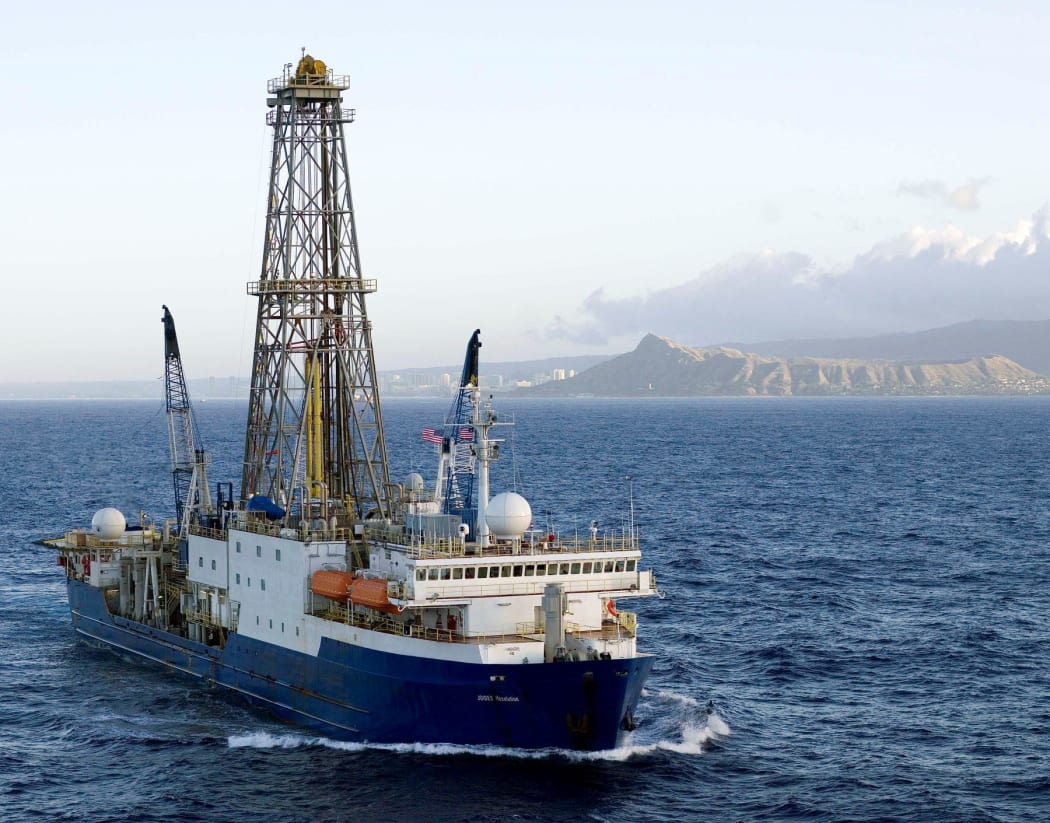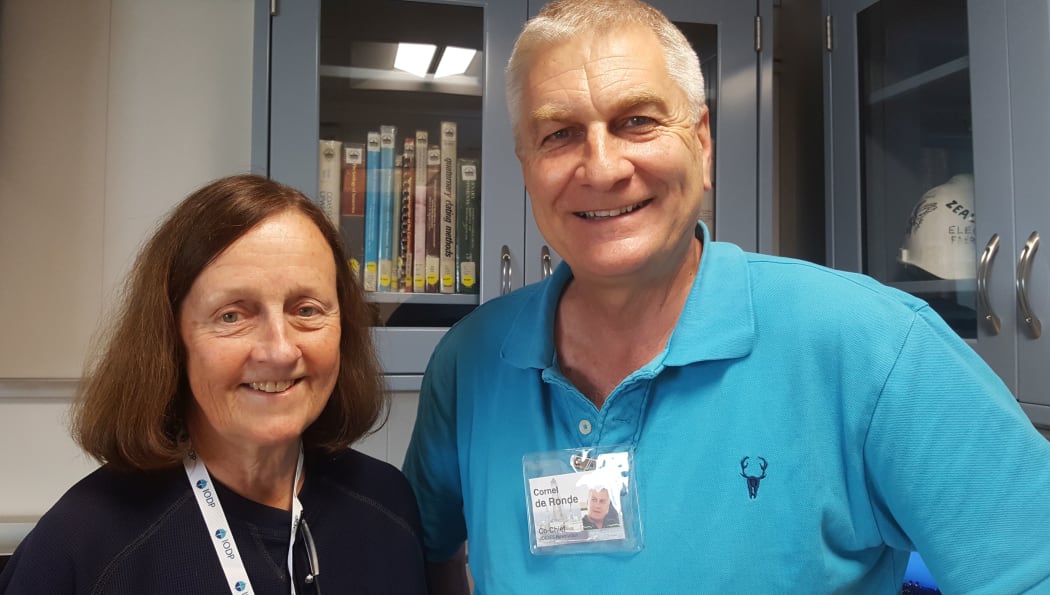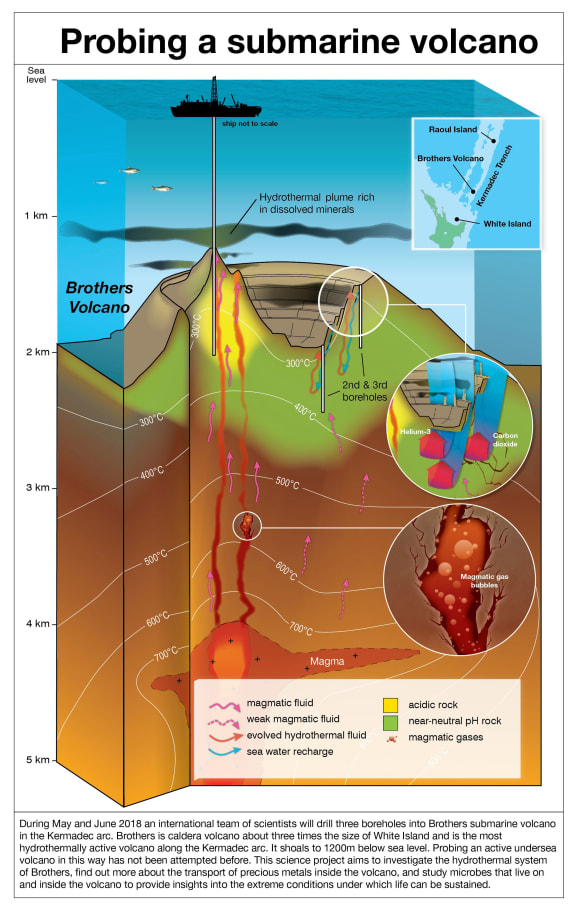Brothers is a massive submarine volcano in the Kermadec Arc, 400km northeast of White Island. It is a hydrothermal volcano, known for its hot springs and tall chimneys known as black smokers.
Over the next two months an international team of geologists will drill into the active volcano in a world-first effort to learn more about how metals such as gold move through the earth’s crust.

Voyage co-leader Cornel de Ronde superimposed on a 3D image of Brothers submarine volcano showing the cone where scientists will drill to explore the internal plumbing of the volcano. Photo: Darren D’Cruz, GNS Science
Subscribe to Our Changing World for free on Apple Podcasts, Spotify, Stitcher, RadioPublic or wherever you listen to your podcasts
Over the last 20 years, geologist Cornel de Ronde from GNS Science has been on more than 12 research expeditions to study underwater Brothers volcano, which is three times the size of White Island and arguably the world’s most hydrothermally active volcano.
“We have mapped it in great detail,” says Cornel. “We know about all the hot springs there, about the mineralisation and animals and so on, but something we don’t know about is the third dimension.”
That third dimension is what lies beneath the surface, and is the focus of a two-month expedition that sailed from Auckland this week.
An international team of geologists and drillers are on board the JOIDES Resolution, a research ship operated by the International Ocean Discovery Programme (IODP). They plan to drill three boreholes, the first time this has been undertaken anywhere in the world on an active submarine volcano.

The JOIDES Resolution drilling ship carried out six two-month long research expeditions around New Zealand in 2017. Photo: IODP
“It’s the kind of volcano associated with subduction zones,” says Susan Humphris from the Woods Hole Oceanographic Institution. “The subduction of one [tectonic] plate beneath the other, and the release of water causes the rocks to melt and creates volcanoes.”
“It’s an arc volcano, which is very different in chemistry to the volcanoes you find on mid-ocean ridges.”
The drilling team will be using a number of techniques to attempt to drill as deep as 800 metres into the rocky volcano.
“It’s a lot of unknowns,” says Cornel. “Technologically it’s challenging, but also the environment is extremely challenging. There are fluids exiting that volcano at temperatures over 300°C so I suspect we could have temperatures down there over 400°C.”
Cornel says they already know that some of the fluids exiting hydrothermal vents on the volcano are more acidic than fluids found in car batteries.

Susan Humphris from the Woods Hole Oceanographic Institution and Cornel de Ronde from GNS Science. Photo: RNZ / Alison Ballance
Looking for metals
“We are drilling right into the guts of a volcano,” says Cornel, “and we are hoping to intersect a brine, or a very salty, dense fluid that is more likely to carry metals than other fluids.”
Cornel and Susan are particularly interested in metals such as copper, gold, silver and molybdenum. They are hoping to discover more about how such metals are transported from the Earth’s mantle and how they accumulate in submarine volcanoes.
Cornel says a better understanding “may help in the extraction of these economically important and critical metals.”

Photo: GNS Science
Is there any risk from drilling into an active volcano? Cornel says no, although there could be a risk to the drilling equipment from corrosive fluids and from getting stuck in tough rock.
Susan says this is a new frontier in marine geology.
“In the past 50 years there have been probably three other attempts to do this. They have all been on mid-ocean ridges in different environments,” she says.
“So this is really the first time that we’ve drilled on a volcano of this type, that’s associated with hot springs coming out of the seafloor, and that are quite acidic. Some of them are quite gassy, full of gases, and so it is going to be very different.”
Looking for life
The expedition is also interested in the unique microbial life that is found on the volcano.
“It’s certainly possible that in the subsurface layers of this volcano there are microbiological communities living in high temperatures,” says Susan. “And hopefully we’ll find new species that have never been seen before.”
Studying microbes in extreme environments such as this has implications for how we search for life on other planets, and for understanding how early life on Earth evolved.
Susan also says the kinds of technology used to study remote ocean environments could be used to explore other planets with water on them.
The Brothers volcano expedition is the fifth of six two-month-long expeditions the JOIDES Resolution is undertaking around New Zealand.
Voyage 376 includes a science educator and communicator who will be posting regular updates from the ship.
IODP is an international research collaboration that conducts seagoing expeditions to study Earth’s history and dynamics recorded in sediments and rocks beneath the ocean floor.
New Zealand participates in IODP through a consortium of research organisations and universities in Australia and New Zealand, including GNS Science, NIWA, University of Auckland, Victoria University of Wellington, and University of Otago.


